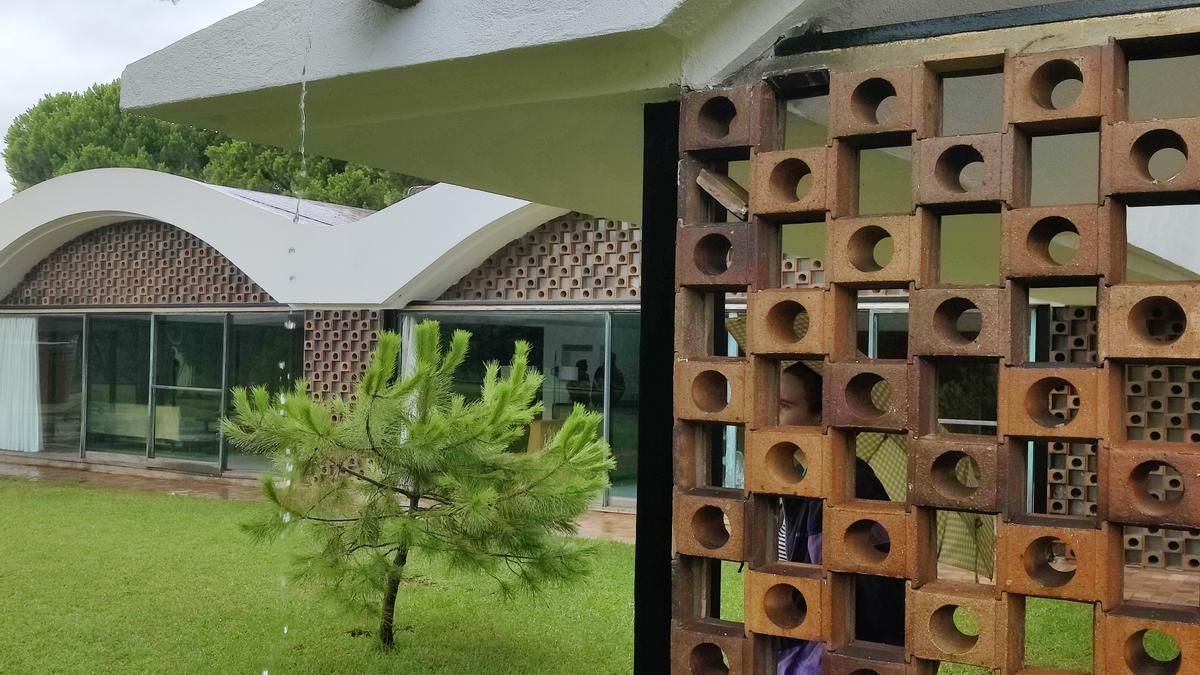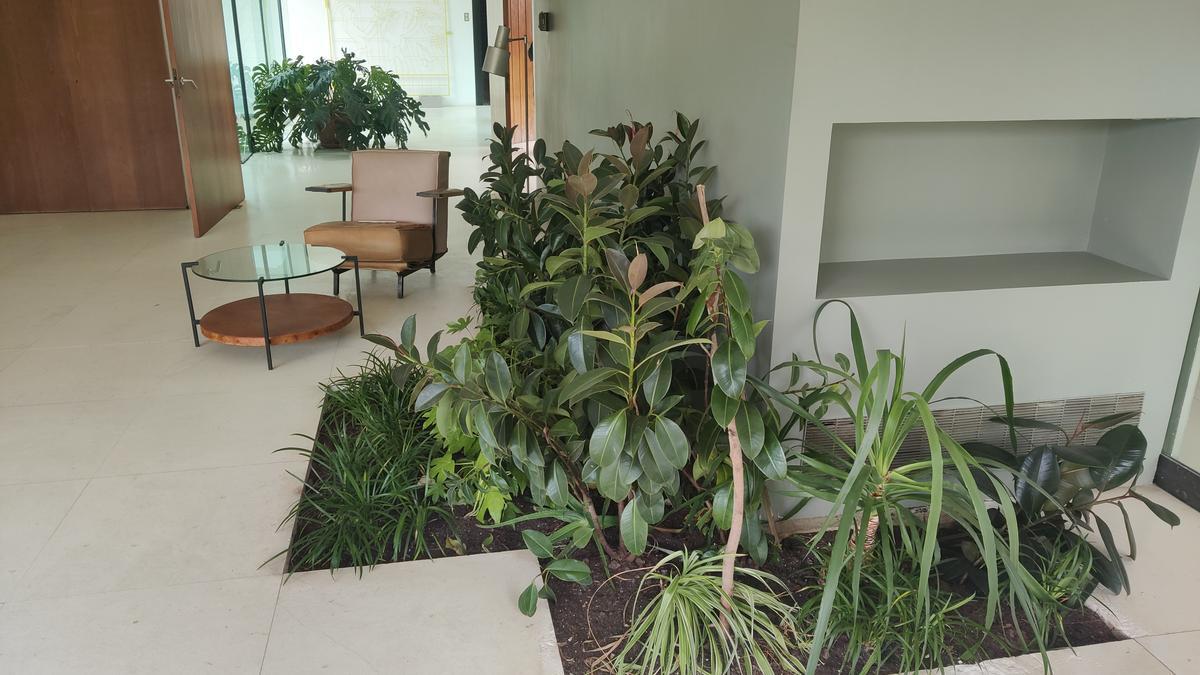In any artistic discipline the location of the work can be as important as the work itself, but that is especially true in architecture. There would be no pyramids without the Nile, nor Notre Dame without Ile de la Cité, nor Cascade House without a waterfall. Casa Gomis is one of the best examples of Mediterranean rationalist architecture, but it is also a symbol of the context where it is located: La Ricarda, a threatened natural space on the southern coast of Barcelona.
The Ministry of Culture has just formalized the sale for 7.2 million euros of the house and the property that contain this delicate building, designed by the architect Antoni Bonet Castellana in close collaboration with the owner couple, formed by Ricardo Gomis and Inés Bertrand . It is an acquisition that has several reasons, although the main one of all is the conservation of a heritage that the family found difficult to maintain.
But it is no coincidence that the team of Minister Ernest Urtasun, of the Comuns-Sumar, has decided to purchase a place that, in recent years, had also become a symbol against the expansion of the El Prat Airport.
The Ministry of Transportation’s plans included lengthening the third runway of the aerodrome, which would have meant building on protected land and, probably, modifying the surroundings of the house, classified in 2021 as a Cultural Asset of National Interest by the Generalitat. That is why the acquisition by the Ministry, although it does not change the situation in practice, does send a message in favor of the conservation of the area.
Culture has also carried out the operation in record time, using a remainder of the 2024 budget. A sale that, however, has been successful due to the predisposition of the Gomis Bertrand family, now made up of six heirs.

“We have always understood that we had an iconic heritage. But people are unaware that having an asset of cultural interest implies a series of obligations, for which it is necessary to have financial capacity,” explains Inés Gomis, one of the heirs. During the years that the parents lived, until 1993, the family always considered that they could pay for the maintenance by operating the property itself, which was used for cultural events and social activities.
But that began to change around the ’92 Olympics, when air traffic intensified and Aena began to show interest in purchasing land in the area. The company that manages the airport proposed a soundproofing plan to which it was obliged, but that meant modifying the structure of the house, something prohibited.
“We have spent the last decades looking for solutions and we have discussed the problem with all administrations, from Aena to the Generalitat. We have been precarious for 20 years and, after all this time, the possibility arose that the Ministry of Culture would buy it. We had to decide the sale in a few weeks, from September when it began to take shape until December 30, when we closed it,” explains Gomis.
Public commitment and family mourning
“There is always a mourning when you part with artistic heritage, but the fact that it is going to be public is a consolation, because you will always have the opportunity to see it again,” explains Inés Gomis. In his case, the grief over the loss of the house had been maturing over the last 20 years. But for other members of your own family, things will be different. “Everyone lives it in a different way,” he summarizes.
The Gomis Bertrands said goodbye on December 26 to what was always their home. They did so at a meeting attended by around fifty descendants of that music-loving couple from the upper bourgeoisie who opted for a modern architect for their beach house. “It will be the last time we celebrate Christmas in the house, as we have always done since it was inaugurated,” explains the sister.

Despite the sentimental value, the family has been convinced and satisfied with the sale. But the real driver of this public acquisition of heritage is Jordi Martí, current Secretary of State for Culture and a man who has literally been behind the house for two decades.
“The work of Bonet Castellana is the best exponent of Catalan rationalism and GATCPAC, it is one of the best we have here, but it has not been valued enough because we have prioritized other styles,” explains Martí. According to him, as head of Culture at Barcelona City Council, at the beginning of the 2000s he himself had contacted the Gomis family to find out how they viewed a possible sale, despite the fact that the property is located in another town. The Prat.
For Martí, the most important objective was to guarantee its conservation and make it easier for it to be visited. “Barcelona is a city wedged between two rivers, the Besòs and the Llobregat. And at both ends we have two architectural exponents of the nerve of our history: the house of enjoyment of the enlightened bourgeoisie, the Gomis house, and at the opposite end, the Tres Xemenèies factory, which represents working-class Barcelona. It is important that neither of them are lost,” summarizes Martí.
A jewel of Catalan rationalism
The land on which Casa Gomis is built initially belonged to Manuel Bertrand, grandfather of the current owners on his mother’s side. The farm, conceived as a hunting reserve, was distributed to his children as they got married. According to their daughters, Ricardo and Inés were given the furthest plot because they were the “peculiar” couple in the family.
In the early 1950s, the cosmopolitan couple would begin to plan what they wanted to be their recreational home, in a privileged natural environment and ten minutes in a straight line from El Prat beach. Ricardo established a relationship with Bonet Castellana, a disciple of Le Corbusier and who had been part of the influential GATCPAC, described by some as a Catalan ‘Bauhaus’.
The only problem is that Bonet Castellana was exiled in Argentina, so he had to execute the plans from there so that a builder could make them in El Prat. Correspondence flies between Barcelona and Buenos Aires, a first two-story project is even drawn up that ends up being discarded to make a building much more integrated into the landscape.

Finally, in 1953, Bonet Castellena sent his proposal, which fell in love with the Gomis Betrand couple. It was a building made up of identical modules measuring 8.8 meters on each side. Each of these squares has a dome made following the Catalan vault technique and which is also independent of the interior enclosure.
From these modules, 11 in total although two of them are open to the outside, a complete home is arranged, with separate rooms for the couple and children, with large common areas such as a huge living room, a dining room with a full kitchen and passage spaces.
The integration of the house into the exuberant nature of the location is achieved through reciprocal adaptation. The modules are located inside a clearing in the forest, but at the same time they let nature in thanks to their semi-openness, which in some areas becomes interior spaces in which vegetation emerges.

If something stands out about the design, it is that every corner of the house is designed for rest and artistic enjoyment, with a sound that reveals the enormous interest that the couple had in music. Almost seven decades later, the house still has the original furniture, some designed by Bonet Castellana himself, such as the ‘butterfly’ chair, but also original appliances and an advanced electrical control system for all appliances.
A cultural refuge in the worst of Franco’s regime
The already mentioned sound of all the spaces in the house, thanks to the Catalan vault, was one of the couple’s requests to Bonet Castellana. As a music fan, Ricardo Gomis had an advanced recording device that he wanted to use in his recreational residence, as well as a piano that was always ready for both family and visitors.
These conditions, added to the seclusion of the property, over time turned Casa Gomis into an artistic hotbed within the cultural wasteland of Francoism in the 50s and 60s. “I remember great concerts that were held in those years, like the one at Jean-Pierre Rampal, which the children organized with the help of my father,” explains Inés Gomis.

Ricardo himself had commissioned the composer Robert Gerhard to create a work for the inauguration of the La Ricarda house, which ended up being called Concert for 8 (after the members of the Gomis Bertrand family).
But other times the concerts were much more improvised. “One day Tete Montoliu came with some of my cousins. He was with his trio, but they came to dinner. There were a few of us, but not many of us who would have been there to receive Tete Montoliu, who ended up playing the piano,” Sister Gomis remembers.
Another anecdote that the family usually remembers is when Montserrat Caballé, undergoing surgery after giving birth to her daughter, suffered stage fright when she believed she had lost her faculties. Father Gomis then invited her to his house to record it with his equipment and the soprano, after listening to herself, had to admit that her vocal capacity was still intact.
After Ricardo’s death, the heirs of the couple donated a huge collection of records to the Biblioteca de Catalunya, but also an even rarer gem: 108 sound reels with concerts or poetry recitals recorded under the domes designed by Bonet Castellana.
#ins #outs #sale #Casa #Gomis #jewel #Catalan #rationalism #consolation #public

